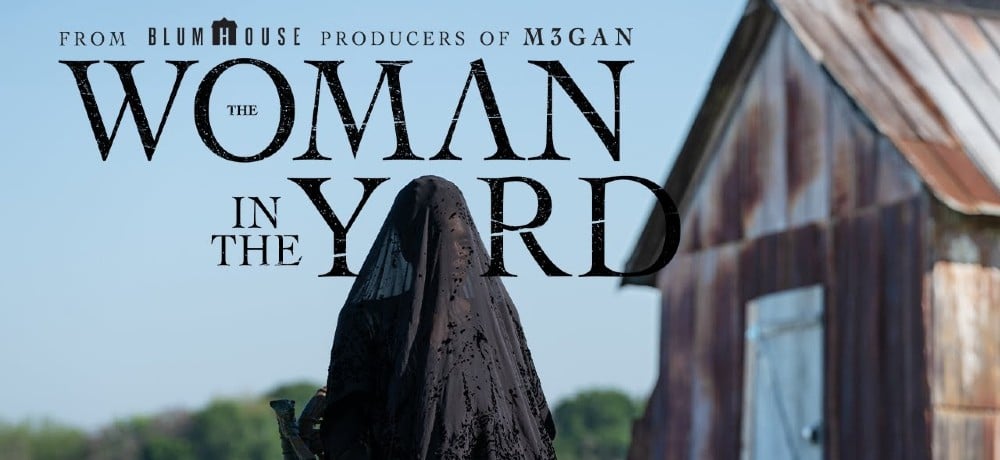


The “Trauma Horror” movement’s demise has been long-coming, but not immediate. This year’s South by Southwest film festival premiered multiple titles that evolved genre usages of emotional storytelling hinged on traumatic events, from live-action Hentai to little grey men with probes. Still, maybe it is time to retire “Trauma Horror.” Jaume Collet-Serra’s The Woman in the Yard is a recycled blueprint of “depression is the monster” perspectives that’s too on the nose, too inevitable, and too paint-by-numbers. Conversations about self-worth and the condition’s stranglehold are all too real, and yet The Woman in the Yard overextends its thematic depth even at an 85-minute length.
Danielle Deadwyler stars as the widowed single mother Ramona, left with a leg injury from a car accident that killed her husband David (Russell Hornsby). She’s alone in the countryside, caring for rebellious teenager Taylor (Peyton Jackson) and little angel Annie (Estella Kahiha). David’s dream of quaint farmland living is now Ramona’s cross to bear, sickened by grief, but also feeling uninspired to generate artwork outside her bustling city lifestyle. Times are hard, but they’re about to get harder when a mysterious figure shrouded in black (Okwui Okpokwasili) appears sitting in her yard. Ramona engages, but the woman only talks in vague circles—and refuses to leave.
Collet-Serra is playing with similar tricks to The Shallows in that he only has a restricted area to generate tension between trapped characters and a looming threat. In this case, Okpokwasili’s funeral-dressed guest sits glaring at Ramona’s powerless household, like she’s waiting to strike. It’s a ghoulish image that unsettles the children, but alarmist suspense is fleeting the more Ramona succumbs to her demons. It’s obvious who the angular, almost skeletal specter is outside as Ramona’s son and daughter start receiving the brunt of their mother’s instability. “The Woman” is trying to drive a wedge, following an expected template of triggers and red flags that stray away from horror-forward embellishments.
Performances aren’t incapable, but the confines of character arcs suffocate in their rigidness. Deadwyler feels stuck in a life she doesn’t know if she wants, left to navigate her immense sadness alone. Taylor and Annie are trying to help, making breakfast—albeit eggs with Dorito crumbles—but Ramona’s incapable of being the loving matriarch they deserve. Unfortunately, her lash-outs can feel overproduced, unable to suppress aggressive outbursts that are a product of her mental prison. It’s appropriate for what depression feels like, yet the film’s sluggishness throughout Romona’s stormy emotional state squanders earnest heartache.
Cinematographer Pawel Pogorzelski does his best to frame “The Woman” against sunbaked fields blowing in the breeze, her statuesque presence a forever threat, but The Woman in the Yard often reads as empty. Pogorzelski’s visuals hug close on overwhelmed faces or sizzling eggs, trying to generate a visual intimacy—he’s a fantastic cinematographer and his shots elevate what’s there—but there’s frequently dead space. Collet-Serra is typically a surgical filmmaker who can hold your attention through a two-hour-plus jungle cruise, but The Woman in the Yard feels better suited for a 20ish-minute short feature. Scene after scene explicitly tells the audience what’s going on, and while writer Sam Stefanak handles the mind games that depression plays with authentic openness—how “The Woman” tries to convince Ramona her family is better off without her—it’s like reading a therapist’s lobby pamphlet.
That’s what’s frustrating. Messages are loud and clear, from a place of love, but the production’s failure as a horror film is a pox upon deeply surfaced cries for help.
**Spoiler** Then there’s the film’s finale, about as unfortunate a non-ending as 2020’s studio disaster The Turning. Throughout The Woman in the Yard, Ramona is teased with suggestions that there’s a mirror realm where she can be happy, not downtrodden and suicidal. It’s “The Woman’s” supernatural deception. Throughout the third act, Ramona battles against “The Woman’s” manipulation à la The Night House—but where things end is a massive unraveling. Collet-Serra tries to instill hope and yet ends on a sobering, gut-punch surprise that … well, without spoilers, mishandles messaging that’s otherwise so crystal clear to that point. It’s like, “What was this all worth, then?” levels of confusion. A “woof,” as some might say. **End Spoiler**
The Woman in the Yard is a rare whiff for one of the most dependable studio filmmakers in today’s business. It’s pointed yet inaccurate, honest yet unconvincing. I can feel the pain and agony behind themes, yet only track wasted opportunities when Collet-Serra cranks the heat on “The Woman’s” shadow-reaching frights (it’s no Nosferatu). “Trauma Horror’s” shining examples like Relic and Hereditary needn’t worry about their crown, because The Woman in the Yard is best described as the last gasp of a dying trend.
Movie Score: 2/5